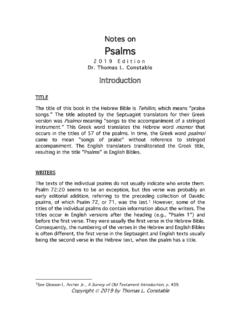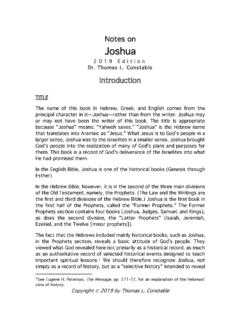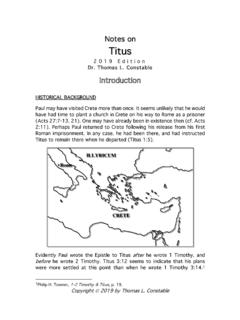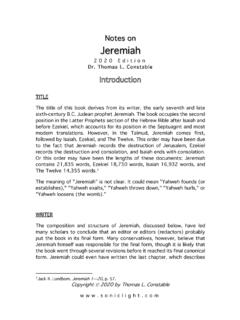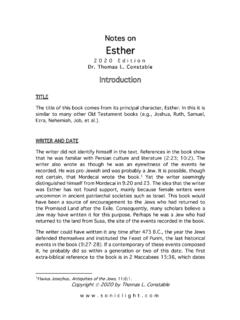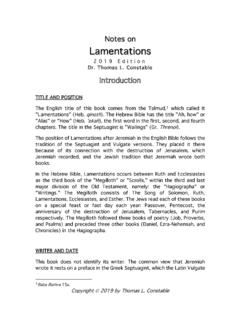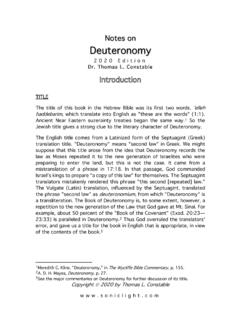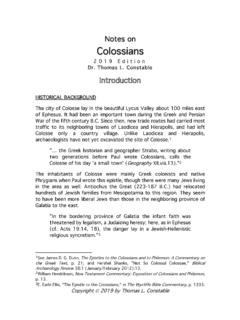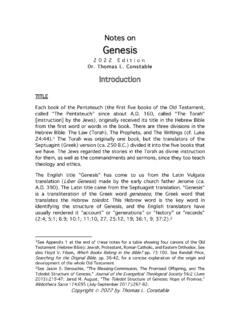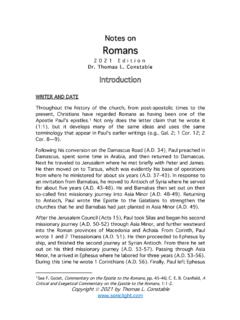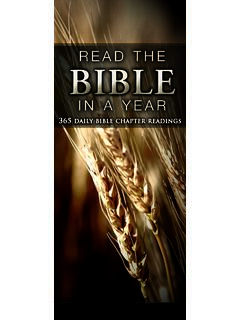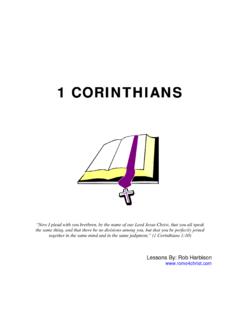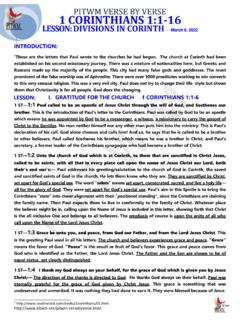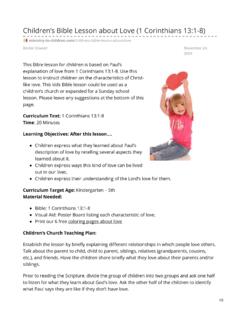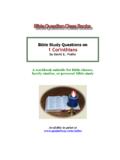Transcription of Notes on 2 Corinthians - Plano Bible Chapel
1 Copyright 2020 by Thomas L. Constable Notes on 2 corinthians 2020 Edition Dr. Thomas L. Constable HISTORICAL BACKGROUND First Corinthians did not dispel the problems in the church at Corinth completely. While it resolved some of them, opposition to the Apostle Paul persisted, and Paul's critics continued to speak out against him in the church. One man in particular seems to have been the ringleader of the opposition (10:7-11). He had rallied the support of a significant minority. The issue was Paul's apostolic authority. His critics were claiming equal authority with Paul. This was in effect a claim to apostolic authority, on their part, and or a denial of the full apostolic authority of Paul. News of continuing problems in Corinth reached Paul, in Ephesus, during his prolonged stay there on his third missionary journey. He then made a brief visit to Corinth. However, his efforts to resolve the conflicts proved unsuccessful (2:1; 12:14; 13:1-2).
2 Paul apparently suffered insult and he lost face during that visit (7:12). Consequently, that was a painful visit for Paul. He then returned to Ephesus. Paul's next step, in dealing with the situation in Corinth, was to send a "severe letter" from Ephesus by the hand of Titus and another unnamed brother (2:3-4; 7:8-12; 12:18). He apparently directed this letter, now lost, at the party opposed to him and particularly its leader. Some commentators believe that 2 corinthians 10 13 contains part or all of this letter, but the evidence for this is not Paul evidently intended to receive Titus' report, concerning the effects of this "severe letter," in Ephesus. However, persecution there made it expedient for Paul to leave that city earlier than he had anticipated (Acts 1 See Richard Batey, "Paul's Interaction with the Corinthians ," Journal of Biblical Literature 84 (1985):139-43. 2 Dr. Constable's Notes on 2 corinthians 2020 Edition 20:1).
3 He found an open door for the gospel to the north in Troas. Eager to meet Titus, who was taking the land route from Corinth back to Ephesus, Paul moved west into Macedonia (2:12-13). There Titus met him and gave him an encouraging report (7:6-16). Most of the church had responded to Paul's directives, and the church had disciplined the troublemakers (2:5-11). Unfortunately, some in the congregation still refused to acknowledge Paul's authority over them (10:1 13:10). Many scholars have tried to explain the different subject matter and tone of chapters 10 13, as compared with chapters 1 9. Some believe chapters 10 13 were a separate letter, specifically: Paul's "severe letter." Others argue that it was originally part of 2 corinthians , and that Paul wrote the whole book at one time. Some scholars believe chapters 10 13 were originally a different letter from chapters 1 9 and from the "severe letter": thus constituting a "fifth" letter from Paul to the Corinthians .
4 Perhaps the best explanation is that chapters 10 13 were originally part 2020 Edition Dr. Constable's Notes on 2 corinthians 3 of 2 corinthians , but that Paul wrote these chapters after he had written chapters 1 9, and after he had met In chapters 10 13, Paul rejoiced at the repentance of the majority in the church. However, his concern for the unrepentant minority, and his desire to pick up the money the Corinthians had begun to collect for their poorer brethren in Jerusalem, led him to write 2 corinthians . Along with these primary motives, Paul also felt compelled to refute the charge of fickleness leveled at him by his critics. He had changed his travel plans and had not come to see them, as he had originally said he wanted to do. The whole situation provided him an opportunity to clarify the nature of Christian ministry. Like 1 corinthians , 2 corinthians is an "occasional" letter: one occasioned by concrete issues.
5 Paul wrote the Second Epistle to the Corinthians from Macedonia: perhaps from Philippi, Thessalonica, or Berea, probably in the fall or winter of 56. A date a year earlier or later is possible. Some commentators believe Paul wrote 1 corinthians after his painful visit and after he wrote the severe letter. Others, and I, believe it is more probable that he wrote 1 corinthians before these two events. It is very difficult to reconstruct the details of Paul's activities, since the data available to us is incomplete. PAUL'S CORINTHIAN CONTACTS Paul's first visit His "former letter" Their letter to him 1 corinthians Paul's "painful visit" His "severe letter" 2 corinthians Paul's future visit 1 See Donald A. Carson and Douglas J. Moo, An Introduction to the New Testament, pp. 430-36. See Kenneth G. Hanna, From Gospels to Glory, pp. 209-11, for further discussion of the unity of the epistle. 4 Dr.
6 Constable's Notes on 2 corinthians 2020 Edition Another view is that the "former letter" is 1 corinthians , and "the offender" (2 Cor. 2:5; 7:12) is the incestuous man of 1 corinthians 5 "According to this view, there was 'no painful visit,' for the word 'again' in 2:1 does not necessarily mean that Paul made a visit between writing First and Second Corinthians . It simply means he did not want to return 'in sorrow.' The reference in 12:14 and 13:1, 2 to a 'third time' does not mean Paul was coming for his third time; it simply means that he was 'ready to come for a third time. He had planned to come (see 1 Cor. 16:5-9), evidently was ready to come (12:14), and then did not actually make the trip (1:15-17, 23)."2 J. Sidlow Baxter observed that Romans, 1 and 2 corinthians , and Galatians follow the order of 2 Timothy 3:16: Romans dealing mainly with doctrine, the Corinthians letters with reproof, and Galatians with PURPOSE Paul's immediate purpose in 2 corinthians was to combat the influence of Judaizers who promoted legalistic teaching.
7 These teachers were evidently Jews, mainly from Judea, who claimed to be Christians. They may have been unbelievers or misguided believers, but they claimed to be Christians. Acts 15:1 refers to them. God s larger purpose in inspiring 2 corinthians was to make the gospel crystal clear. Kenneth Hanna noted five purposes: to console and encourage the majority in the church, to restore the disciplined member of the church, to complete the collection for the saints in Jerusalem, to vindicate Paul's apostleship in view of criticisms, and to prepare for Paul's third visit to , J. H. Bernard, "The Second Epistle to the Corinthians ," in The Expositor's Greek Testament, 3:3-18. 2 The Nelson Study Bible , p. 1942. 3J. Sidlow Baxter, Explore the Book, 6:127. 4 Hanna, pp. 215-16. 2020 Edition Dr. Constable's Notes on 2 corinthians 5 CHARACTERISTICS "While the epistle to the Galatians is the defence [sic] of the doctrine of the Gospel against false teachers, the second epistle to the Corinthians is the defence of his own personal character, his apostolic authority, his motives and his ministry.
8 "1 "It was written with a quill dipped in tears, from the apostle's 'anguish of heart,' and contains more of human pathos than any other of his letters."2 " 2 corinthians is very different from the letters between which it was written, 1 corinthians and Romans. Whereas each of those letters is, in its own way, systematic and orderly, 2 corinthians is, on the face of it, uneven and digressive. It is no surprise, therefore, that many scholars have suggested that 2 corinthians is really a collection of letters put together later as a single letter."3 "Second Corinthians presents many inspiring texts and passages to the reader and teacher of God's Word. A quick survey reveals approximately eighty individual verses lending themselves to extended meditation and exposition, apart from the sixty or so constituent paragraphs of the letter. This letter is a rich lode for the edification of God's people.
9 "4 "In Second Corinthians Paul bares his heart and his life as he does in none of his other letters. This lends a special value to the letter."5 1 Arno C. Gaebelein, The Annotated Bible , 3:2:149. 2 Baxter, 6:121. 3 Paul Barnett, The Second Epistle to the Corinthians , p. 15. Cf. Alfred Plummer, A Critical and Exegetical Commentary on the Second Epistle of St. Paul to the Corinthians , p. xiii. 4 Ibid., p. 47. 5 Richard Lenski, The Interpretation of St. Paul's First and Second Epistles to the Corinthians , p. 804. 6 Dr. Constable's Notes on 2 corinthians 2020 Edition "Of all the Pauline epistles, 2 corinthians is probably the one which presents most problems to the interpreter."1 C. K. Barrett called 2 corinthians ".. surely the most difficult book in the New Testament."2 He meant the most difficult to interpret. OUTLINE I. Introduction 1:1-11 A. Salutation 1:1-2 B. Thanksgiving for comfort in affliction 1:3-11 1.
10 Thanksgiving for comfort 1:3-7 2. Thanksgiving for deliverance 1:8-11 II. Answers to insinuations about the sincerity of Paul's commitment to the Corinthians and to the ministry 1:12 7:16 A. Defense of Paul's conduct with regard to his promised visit and the offender 1:12 2:17 1. The postponement of the intended visit 1:12 2:4 2. The treatment of the offender and the result of the severe letter 2:5-17 B. Exposition of Paul's view of the ministry 3:1 6:10 1. The superiority of Christian ministry to Mosaic ministry 3:1-11 2. The great boldness of the new ministers 3:12 4:6 3. The sufferings and supports of a minister of the gospel 4:7 5:10 4. The life of a minister of Christ 5:11 6:10 C. Appeal for restoration of the Corinthians ' confidence in Paul 6:11 7:16 1 Editor's preface to the second edition of Philip E. Hughes, Paul's Second Epistle to the Corinthians , p. xi. 2C. K. Barrett, A Commentary on The First Epistle to the Corinthians , p.
